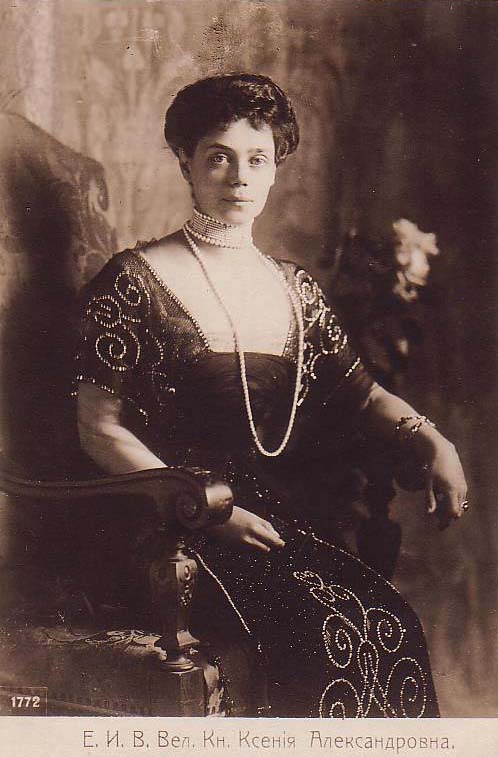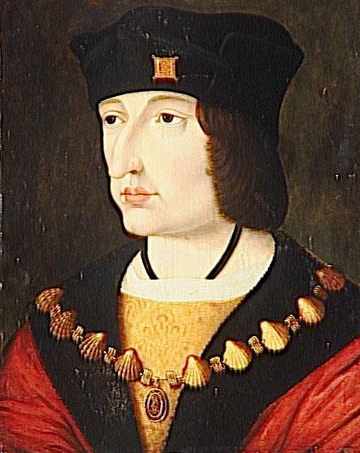© Unofficial Royalty 2025

Grand Duchess Xenia Alexandrovna of Russia; Credit – Wikipedia
April 6, 1199 – Death of King Richard I of England (the Lionheart) at the Siege of Chalus in France; buried at Fontevrault Abbey near Chinon, France
IN 1189, Richard succeeded his father, King Henry II. He spent very little time in England, perhaps as little as six months, during his ten-year reign. Rather than regarding the Kingdom of England as a responsibility requiring his presence as the king, Richard saw England as a source of revenue to support his armies. Most of his reign was spent on Crusade, captivity, or defending his lands in France. In March 1199, Richard was suppressing a revolt by besieging a castle, the Château de Châlus-Chabrol in Châlus in the present-day Limousin region in western France. On the evening of March 25, 1199, Richard was walking the perimeter of the castle, observing the trenches that were being dug. Not wearing his chainmail, Richard was hit by an arrow from a crossbow shot by a soldier on the castle battlements. The wound became infected. Richard’s mother, Eleanor of Aquitaine, arrived before Richard’s death. He died in his mother’s arms.
Unofficial Royalty: King Richard I of England
April 6, 1752 – Death of Charlotte Helene von Schindel, mistress of Frederik IV, King of Denmark and Norway, in Flensburg, Denmark, now in Germany
After the death of his mistress Elisabeth Helene von Vieregg, Frederik IV began an affair with her lady-in-waiting, Charlotte Helene von Schindel. As he did with his previous mistress, Frederik wanted to again make a bigamous marriage with Charlotte. He received strong opposition from Lutheran church leaders who told him that the law against bigamy also applied to kings. Charlotte’s relationship with Frederik IV ended in 1711 when he began another relationship. Charlotte had an active social life and had a relationship with Major-General Ernst Gotschalck von Bülow, the governor of Antvorskov Castle, with whom she had a son, Frederik August Gotschalck von Bülow. When King Frederik IV heard about the child, he ordered von Bülow to marry Charlotte. After her husband’s death, Charlotte lived with her sister in Silesia, then part of the Kingdom of Prussia. Despite her annual pension, Charlotte died in poverty on April 6, 1752, aged 62.
Unofficial Royalty: Charlotte Helene von Schindel, mistress of Frederik IV, King of Denmark and Norway
April 6, 1765 – Birth of Carlo Felice, King of Sardinia at the Royal Palace in Turin, Kingdom of Sardinia, now in Italy
As the third son, Carlo Felice was not expected to succeed to the throne. In 1802, Carlo Felice’s brother Vittorio Emanuele became King of Sardinia upon the abdication of his brother Carlo Emanuele, who was despondent after the death of his wife. There was a succession crisis in the Kingdom of Sardinia. The abdicated Carlo Emanuele was childless. The current king, Vittorio Emanuele, had five surviving daughters who could not succeed to the throne, and his only son had died at the age of three from smallpox. The three other brothers of Carlo Felice, Vittorio Emanuele, and Carlo Emanuele had all died unmarried. In 1807, Carlo Felice married Maria Cristina of Naples and Sicily, but their marriage was also childless. In 1821, liberal revolutions were occurring throughout Italy. However, Vittorio Emanuele I was not willing to grant a liberal constitution, so he abdicated the throne of Sardinia in favor of his brother Carlo Felice. Upon the death of Carlo Felice, the main line of the House of Savoy became extinct. When Carlo Felice died on April 27, 1831, he was succeeded by the senior male member of the House of Savoy-Carignano, who reigned as Carlo Alberto I, King of Sardinia.
Unofficial Royalty: Carlo Felice, King of Sardinia
April 6, 1830 – Death of Ludwig I, Grand Duke of Hesse and by Rhine, in Darmstadt, Grand Duchy of Hesse and by Rhine, now in Hesse, Germany; first buried in the Darmstadt Stadtkirche, in 1910 his remains were moved to the Altes Mausoleum in the Rosenhöhe in Darmstadt
In 1777, Ludwig married Luise of Hesse-Darmstadt, his first cousin, and they had six children. Ludwig succeeded his father in April 1790 as Ludwig X, Landgrave of Hesse-Darmstadt. After the fall of the Holy Roman Empire in 1806, the Landgraviate of Hesse-Darmstadt was raised to the Grand Duchy of Hesse, and Ludwig X, Landgrave of Hesse-Darmstadt, became the first Grand Duke, Ludwig I. As Grand Duke, Ludwig granted the first constitution and worked to establish cultural institutions in the Grand Duchy. He established the court theater and the court library and promoted the arts. He is also credited with creating the Botanical Garden in Darmstadt. Grand Duke Ludwig I died on April 6, 1830, at the age of 77.
Unofficial Royalty: Ludwig I, Grand Duke of Hesse and by Rhine
April 6, 1875 – Birth of Grand Duchess Xenia Alexandrovna of Russia, daughter of Alexander III, Emperor of All Russia, at Anichkov Palace in St. Petersburg, Russia
Xenia was the daughter of Alexander III, Emperor of All Russia, and the sister of Nicholas II, Emperor of All Russia. In 1894, Xenia married Grand Duke Alexander Mikhailovich, known as Sandro, the son of Grand Duke Michael Nikolaevich of Russia, who was a son of Nicholas I, Emperor of All Russia. Xenia and Sandro had one daughter and six sons. Xenia was one of the fortunate Romanovs who survived the Russian Revolution. She left Russia for good aboard the British battleship HMS Marlborough with her mother, Empress Maria Feodorovna (born Dagmar of Denmark), her five youngest sons, her daughter Irina, and Irina’s husband Prince Felix Yusupov. Xenia settled in England, where she was granted management letters for the British properties of her brother Nicholas, which gave her an income of 500 pounds sterling per year. By 1925, Xenia’s financial situation was desperate, and her first cousin King George V allowed her the use of Frogmore Cottage, a grace and favor house, in Windsor Great Park. In March 1937, King George VI, Xenia’s first cousin once removed, granted her the use of Wilderness House, a grace and favor house, on the grounds of Hampton Court Palace, where she died on April 20, 1960, at the age of 85.
Unofficial Royalty: Grand Duchess Xenia Alexandrovna of Russia
April 6, 1889 – Death of Augusta of Hesse-Kassel, Duchess of Cambridge, wife of Prince Adolphus, Duke of Cambridge, at St. James Palace in London, England; buried at St. George’s Chapel, Windsor Castle in Windsor, England
Augusta was the daughter of Prince Friedrich of Hesse-Kassel and Princess Caroline of Nassau-Usingen. Her father was the son of Landgrave Friedrich II of Hesse-Kassel and Princess Mary of Great Britain, daughter of King George II of Great Britain. After the tragic death in childbirth of Princess Charlotte of Wales, the only legitimate grandchild of King George III, the king’s aging bachelor sons needed to seek brides to provide for the succession. Of all the bachelor sons, Prince Adolphus, Duke of Cambridge was the most eligible. He married Augusta of Hesse-Kassel. The groom was 44 and the bride was 20. Despite the age difference, the marriage was happy, and the couple had three children. Augusta and Adolphus are the ancestors of the current British royal family. Their youngest child, Princess Mary Adelaide of Cambridge, was the mother of Princess Victoria Mary of Teck, later Queen Mary, the wife of King George V of the United Kingdom. Augusta survived her husband by 39 years, dying at age 91 on April 6, 1889. She was the last surviving daughter-in-law of King George III. Queen Victoria wrote of her death: “Very sad, though not for her. But she is the last of her generation, & I have no longer anyone above me.”
Unofficial Royalty: Augusta of Hesse-Kassel, Duchess of Cambridge
April 6, 1904 – Death of Sophie of Baden, Princess of Lippe, wife of Woldemar, Prince of Lippe, in Karlsruhe, Grand Duchy of Baden, now in Baden-Württemberg, Germany; buried in the Mausoleum at the Büchenberg in Detmold, Principality of Lippe, now in North Rhine-Westphalia, Germany
The daughter of Prince Wilhelm of Baden and Duchess Elisabeth Alexandrine of Württemberg, Sophie married Woldemar, the future Prince of Lippe in 1858. Their marriage was childless. Woldemar became Prince of Lippe upon the death of his childless elder brother Leopold III in 1875. Woldemar, Prince of Lippe died in 1895. Sophie survived her husband Woldemar by nine years, dying at the age of 70, on April 6, 1904, at the age of 70.
Unofficial Royalty: Sophie of Baden, Princess of Lippe
April 6, 1962 – Death of Bathildis of Schaumburg-Lippe, Princess of Waldeck and Pyrmont, wife of Friedrich, Prince of Waldeck and Pyrmont, in Arolsen, West Germany, now in Germany; buried in the Princely Cemetery at Schloss Rhoden in Rhoden, now in the German state of Hesse
Bathildis was the wife of Friedrich, the last reigning Prince of Waldeck-Pyrmont. The couple married in 1895 and had four children. After the defeat of the German Empire in World War I, Friedrich abdicated and negotiated an agreement with the new government that gave him and his descendants the ownership of the family home, Arolsen Castle, and the Arolsen Forest. Both Bathildis and her husband Friedrich lived through World War II. While neither joined the Nazi Party, their eldest son Josias, his wife Altburg, and their eldest child Margarethe were members of the Nazi Party. Josias was a convicted Nazi war criminal and was sentenced to life imprisonment for crimes in connection to the Buchenwald concentration camp. His sentence was eventually reduced, and he was released early due to health reasons. Bathildis’ husband Friedrich died in 1946. She survived her husband by sixteen years, dying on April 6, 1962, aged 88.
Unofficial Royalty: Bathildis of Schaumburg-Lippe, Princess of Waldeck and Pyrmont
April 6, 2005 – Death of Prince Rainier III of Monaco at the Cardio-Thoracic Centre in Monte Carlo, Monaco; buried at Saint Nicholas Cathedral in Monaco
Rainier was the second child, and only son, of Princess Charlotte of Monaco, the illegitimate and adopted daughter of Prince Louis II of Monaco, and Count Pierre de Polignac. In May 1944, he became the heir-presumptive to his grandfather, Prince Louis II, following his mother’s renunciation of her succession rights in his favor. Rainier became Prince of Monaco in 1949 upon the death of his grandfather. In 1956, Rainier married American film star Grace Kelly, and they had three children. In 1982, Rainier’s wife Grace died following a car accident. By 2000, Rainier’s health was declining. In January 2005, he made one of his last public appearances, at the International Circus Festival of Monte-Carlo. After several weeks in the hospital, Prince Rainier III passed away at the age of 81. He was succeeded by his son, Prince Albert II, who had been serving as Regent since the prior week. His funeral was held on April 15 at the Saint Nicholas Cathedral, where he was buried beside his late wife Princess Grace.
Unofficial Royalty: Rainier III, Prince of Monaco
This article is the intellectual property of Unofficial Royalty and is NOT TO BE COPIED, EDITED, OR POSTED IN ANY FORM ON ANOTHER WEBSITE under any circumstances. It is permissible to use a link that directs to Unofficial Royalty.










